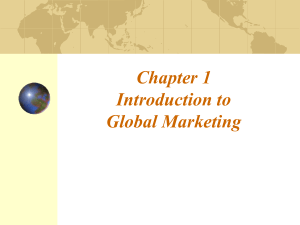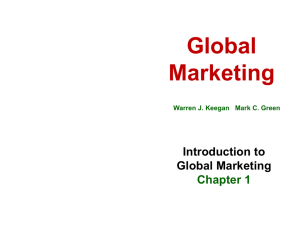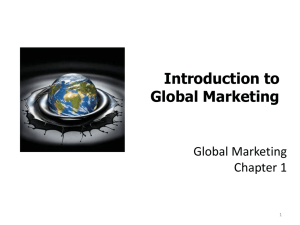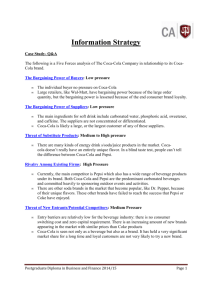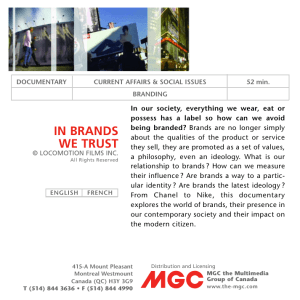Global Marketing Strategy
advertisement
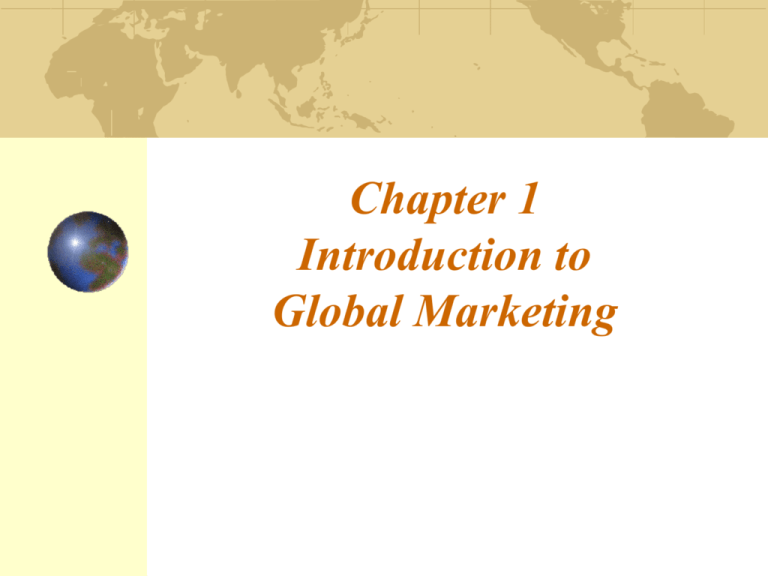
Chapter 1 Introduction to Global Marketing http://www.youtube.com/watch?v=Fucq5BoEfEI 1-2 The 787 Dreamliner Parts Supplier Airframe sections Kawasaki, Fuji, Mitsubishi, Japan Horizontal stabilizer Alenia, Italy Aft Cargo door Saab, Sweden Landing gear Messier-Dowty, France (built in Gloucester, UK) Nose & cockpit sections Spirit Aerosystems, Canada Wing body fairing Boeing, Canada Trailing edge and flaps Hawker de Havilland, Boeing Australia Fairing panels, rudder, leading edge Hafei, Chengdu, Shenyang, China Airplane design Boeing Design Center, Moscow Tail cone South Korea US suppliers Puget Sound, WA; Charleston, SC; Wichita, KS, Tulsa, OK 1-3 The Blackberry Storm http://www.sou rcemap.org/obj ect/blackberrystorm UK, Singapore, South Korea, China, Japan, Malaysia, Scotland, The Netherlands, Taiwan, US (NJ, MA, CA, AZ, TX, ME) 1-4 Globalization – Thomas L. Friedman Globalization is the inexorable integration of markets, nation-states and technologies to a degree never witnessed before—in a way that is enabling individuals, corporations and nationstates to reach around the world farther, faster, deeper and cheaper than every before… The degree of inter-dependence between nation states 1-5 What is a Globally Integrated Enterprise? A collection of various incorporated business units in different countries Bound together by a common, shared objective Part of the business value chain that extends from product inception to final consumption Activities in the value chain are performed by business units most skilled (in that activity) and at the lowest relative cost (on a global basis) 1-6 Sam Palmisano (Chairman and CEO of IBM) What is a globally integrated enterprise Global Integration allows companies to take advantage of talent and resources regardless of time zones and delivers value to customers regardless of geography 1-7 Globalized Industries An industry is global to the extent that a company’s industry position in one country is interdependent with its industry position in another country The number of times business supply chains cross national borders Indicators of globalized industries Ratio of cross-border trade to total worldwide production (in an industry) Ratio of cross-border investment to total capital investment (in an industry) 1-8 Global Marketing: What It Is and What It Isn’t Single Country Marketing Strategy Target market strategy Marketing mix Product Price Promotion Place Global Marketing Strategy Major world market participation thru’ sale of its products Marketing mix development 4 P’s: adapt or standardize? Concentration of marketing activities Coordination of marketing activities Integration of competitive moves 1-9 Why is Global Marketing important? High-growth and Low-growth countries Relative costs Risk of losing domestic business to foreign country competitors Segment simultaneity 1-10 The Importance of Going Global For U.S. companies, 70% of total world market for goods and services is outside the country Coca-Cola earns 75% of operating income and two-thirds of profit outside of North America For Japanese companies, 90% of world market is outside the country 94% of market potential is outside of Germany for its companies 1-11 Product/Market Matrix Global versus “regular” marketing Scope of activities are outside the homecountry market Product/market growth matrix 1-12 Competitive Advantage, Globalization, and Global Industries Focus Concentration and attention on core business and competence Nestle is focused: We are food and beverages. We are not running bicycle shops. Even in food we are not in all fields. There are certain areas we do not touch. . . . We have no soft drinks because I have said we will either buy Coca-Cola or we leave it alone. This is focus. Helmut Maucher, former chairman of Nestlé SA 1-13 Standarization versus Adaptation Globalization (standardization) Developing standardized products marketed worldwide with a standardized marketing mix Essence of mass marketing Global localization (adaptation) Mixing standardization and customization in a way that minimizes costs while maximizing satisfaction Essence of segmentation Think globally, act locally 1-14 Quick example on glocalization Pepsi in India in 1990 Entered through a JV with Voltas & Punjab Agro-Industries Corp to develop vegetable and fruit farming techniques Introduced Pepsi under the name ‘Lehar Pepsi’ Advertising used local Bollywood and cricket celebrities. • http://www.youtube.com/watch?v=fgKgEucccUc • http://www.youtube.com/watch?v=is4X_Tw6nPQ • http://www.youtube.com/watch?v=rfiF6VSFoGc 1-15 Standarization versus Adaptation Arabic read right to left Chinese “delicious/happiness” The faces of Coca-Cola around the world 1-16 McDonald’s Global Marketing Marketing Mix Element Standardization Product Big Mac Localized McAloo Tikka potato burger (India) Promotion Brand name Slang ’Macca’s (Australia) MakDo (Philippines) Place Advertising slogan “I’m Loving It” McJoy magazine, “Hawaii Surfing Hula” promotion (Japan) Free-standing Home delivery (India) Swiss rail system dining cars Price Big Mac is $3.10 in U.S. and Turkey $5.21 (Switzerland) $1.31(China) 1-17 Global Marketplace – Local Markets Brands sold globally – McDonalds, Sony, Lego, Swatch, Burberry, etc. Local brands – Yum Brands’ East Dawning fast Food chain in China; Kiki competes with Vogue and Cosmo in Japan; Ford competes with Maruti in India Global brands and local brands Brands’ sense of identity with a country is blurring 1-18 In what country is the parent corporation located? Firestone Tire & Rubber Miller Beer Ray Ban Rollerblade Rolls Royce Weed Eater RCA Televisions Holiday Inn Jaguar Wild Turkey Bourbon Dr. Pepper ThinkPad Ben & Jerry’s Homemade Wilson Sporting Goods Budweiser Right Guard Gerber Hummer 1-19 In what country is the parent corporation located? Firestone Tire & Rubber Japan (Bridgestone) Miller Beer GB (SABMiller) Ray Ban Italy (Luxottica) Rollerblade Italy (Benetton) Rolls Royce Germany (Volkswagen) Weed Eater Sweden (Electrolux) RCA Televisions China (TTE) Holiday Inn GB (Intercontinental) Jaguar India (Tata Motors) Wild Turkey Bourbon France (Groupe Pernod Ricard) Corona Mexico ThinkPad China (Lenovo) Ben & Jerry’s Homemade GB / Netherlands (Unilever) Wilson Sporting Goods Finland (Amer) Budweiser Belgium (InBev) Right Guard Germany (Henkel) Gerber Switzerland (Nestle) Land Rover India (Tata Motors) 1-20 Management Orientations Ethnocentric orientation Home country is superior to others Sees only similarities in other countries Assumes products and practices that succeed at home will be successful everywhere Leads to a standardized or extension approach 1-21 Management Orientations Polycentric orientation Each country is unique Each subsidiary develops its own unique business and marketing strategies Often referred to as multinational Leads to a localized or adaptation approach that assumes products must be adapted to local market conditions 1-22 Management Orientations Regiocentric orientation A region is the relevant geographic unit • Ex: The NAFTA or European Union market Some companies serve markets throughout the world but on a regional basis • Ex: General Motors had four regions for decades 1-23 Management Orientations Geocentric orientation Entire world is a potential market Strives for integrated global strategies Also known as a global or transnational company Retains an association with the headquarters country Pursues serving world markets from a single country or sources globally to focus on select country markets Leads to a combination of extension and adaptation elements 1-24 own control decentralized polycentric geocentric regiocentric ethnocentric Similarities perceptions differences 1-25 Driving Forces Affecting Global Integration and Global Marketing Regional economic agreements Converging market needs and wants and the information revolution Transportation and communication improvements Product development costs 1-26 Driving Forces Affecting Global Integration and Global Marketing Quality World economic trends Leverage 1-27 Restraining Forces Affecting Global Integration and Global Marketing Management myopia Organizational culture National controls Opposition to globalization 1-28
